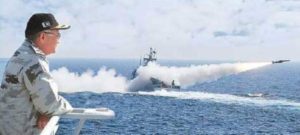
By Ahyousha Khan; January 10, 2018
The year 2017, ended with the commitment by Pakistan to acquire deterrence at all spectrums of threat. At the meeting of National Command and Control Authority, Pakistan resolved to a policy of Full Spectrum Deterrence, which is in line with the policy of Credible Minimum Deterrence. So, to validate its commitment to countering threats at all spectrums, Pakistan marked the beginning of 2018 with the test of naval missile “Harba.”
On January 3rd, 2018 Pakistan successfully tested its indigenous naval cruise missile “Harba” from its newly commissioned fast attack vessel “PNS Himmat.” Harba is capable of hitting its targets from surface to surface and is also capable of ground assault. Moreover, it has demonstrated impressive capabilities in accuracy and precision by hitting its target successfully. This particular development by Pakistan navy was not only an attempt to get another weapon in its arsenal but to exhibit its self-sufficiency in high-tech weaponry.
Another significant aspect of this particular development is Pakistan’s indigenously built naval vessel “PNS Himmat” which is commissioned in the year 2017. PNS Himmat is equipped with state of the art weaponry, sensors, and Harba cruise missiles. It is the second indigenously built fast attack vessel which is capable of high speed, high firepower and enhanced endurance for rapid response at sea. The first indigenously built fast attack vessel by Pakistan was PNS Dehshat, which was inducted into Pakistan Navy in 2012.
These developments by Pakistan in its naval capabilities were due since a long time. Moreover, with interest vested in Gwadar Port and China Pakistan Economic Corridor (COEC), state-level initiatives to strengthen Pakistan Navy for the security of maritime borders and interests are increasing. However, rapid initiatives to enhance navy is not entirely for the sake of Economic Interests. With India being its neighbor, Pakistan was not fortunate enough to spend a lot on its economic growth. Rather security threats from India engulfed Pakistan’s resources. But, if Pakistan’s security choices are analyzed with the pragmatic lens, what other choice was available for Pakistan? None, but to face India with all its ability.
On the other hand, in the realm of naval militarization and nuclearization, India is spending a huge amount on indigenously building SSBNs and SSNs along with aircraft carriers and fleet of naval vessels. This rapid militarization by India is destabilizing strategic equilibrium in the Indian Ocean between India and Pakistan.
Almost a year ago, Pakistan didn’t even have a second strike capability because of its unyielding belief in credible minimum deterrence. However, in response to Indian naval capabilities and its ambitiousness, Pakistan went for the option of second strike capability. It was an attempt to strengthen the deterrence and shared the risk of destruction to keep India at bay.
But, a nuclear-tipped naval cruise missile is not the end of the ladder in second strike capability rather it is the start of the ladder. One of the key elements in making deterrence reliable is a complementary conventional force. The decision to build naval missile system by Pakistan for conventional fast attack vessel supports reinforces the logic that Pakistan is not only building second strike capability but also complementing it with conventional force.
Point to focus on is that Pakistan’s decision was based on the logic that Pakistan wants to stop India at all spectrums whether it be conventional or non-conventional. Furthermore, Pakistan does not always rely on nuclear deterrence to stop India, if it’s possible to avoid reliance on only nuclear weapons, conventional means are preferred for regional peace and stability.
Also, Pakistan’s second-strike capability is based on nuclear-tipped cruise missiles Babur 3. Thus, conversion of naval cruise missile into nuclear-tipped naval cruise missile is the possibility that Pakistan could rely on in future to deter India. Deployment of nuclear cruise missiles on naval vessels is a plausible option for Pakistan to counter Indian threat in Indian Ocean Region. As utilization of other options such as the acquisition of SSBN and SSN is a time taking process. These measures are the options Pakistan may rely on till the development of survivable and credible second-strike capability.
However, in all this mayhem for the acquisition of Second Strike Capability, the logic of nuclear deterrence should prevail to avoid catastrophe and destruction. As it is deterrence that instills the fear of unbearable damage and encourages states not to manipulate the shared risks of destruction. If India and Pakistan want to use the Indian Ocean Region for economic prosperity, they need to let deterrence prevail. Lastly, deployment of cannisterized nuclear assets in Indian Ocean Region will require a certain amount of confidence-building measures by both India and Pakistan to avoid a nuclear crisis.
